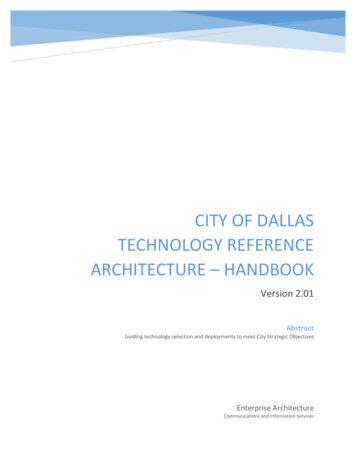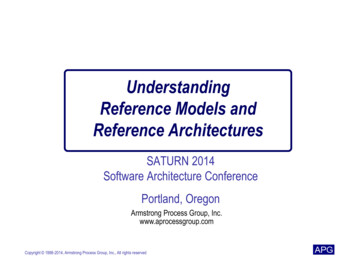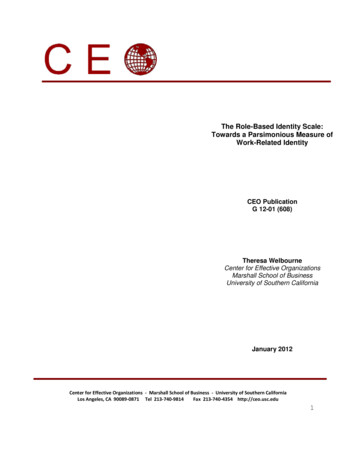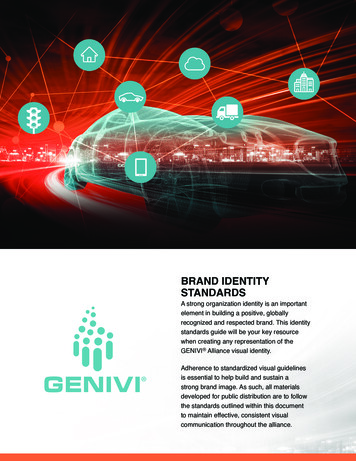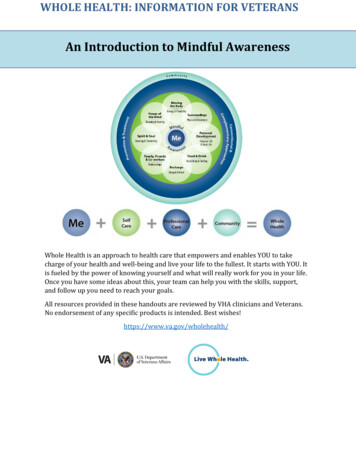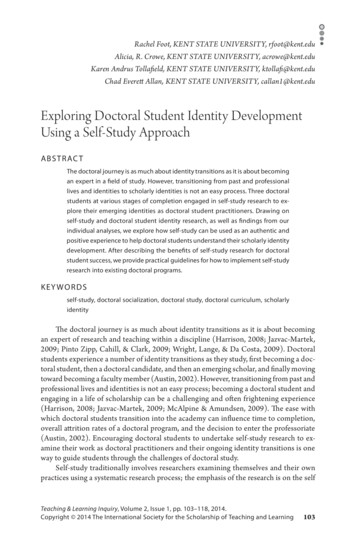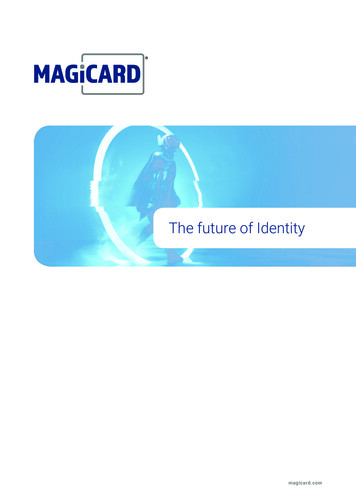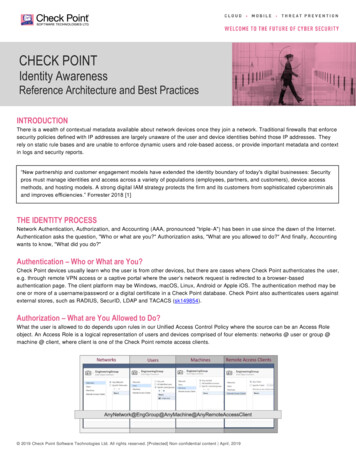
Transcription
CHECK POINTIdentity AwarenessReference Architecture and Best PracticesINTRODUCTIONThere is a wealth of contextual metadata available about network devices once they join a network. Traditional firewalls that enforcesecurity policies defined with IP addresses are largely unaware of the user and device identities behind those IP addresses. Theyrely on static rule bases and are unable to enforce dynamic users and role-based access, or provide important metadata and contextin logs and security reports.“New partnership and customer engagement models have extended the identity boundary of today's digital businesses: Securitypros must manage identities and access across a variety of populations (employees, partners, and customers), device accessmethods, and hosting models. A strong digital IAM strategy protects the firm and its customers from sophisticated cybercrimin alsand improves efficiencies.” Forrester 2018 [1]THE IDENTITY PROCESSNetwork Authentication, Authorization, and Accounting (AAA, pronounced "triple -A") has been in use since the dawn of the Internet.Authentication asks the question, "Who or what are you?" Authorization asks, "What are you allowed to do?" And finally, Accountingwants to know, "What did you do?"Authentication – Who or What are You?Check Point devices usually learn who the user is from other devices, but there are cases where Check Point authenticates the user,e.g. through remote VPN access or a captive portal where the user’s network request is redirected to a browser -basedauthentication page. The client platform may be Windows, macOS, Linux, Android or Apple iOS. The authentication method may beone or more of a username/password or a digital certificate in a Check Point database. Check Point also authenticates users againstexternal stores, such as RADIUS, SecurID, LDAP and TACACS (sk149854).Authorization – What are You Allowed to Do?What the user is allowed to do depends upon rules in our Unified Access Control Policy where the source can be an Access Roleobject. An Access Role is a logical representation of users and devices comprised of four elements: networks @ user or group @machine @ client, where client is one of the Check Point remote access clients. 2019 Check Point Software Technologies Ltd. All rights reserved. [Protected] Non-confidential content April, 2019
For example, it is possible to configure an Access Role object describing a User/Group object that is AND related with the IPaddress range of a network. An Access Role object like this will only match if both dimensions match: a user is part of a gro up ANDthe connection is initiated from the IP network range configured.Further defining what the user is authorized to do, other components of a Unified Access Control Policy rule may be an IP addressor network, a network port or service, an application or URL, a file or data type and the time of day. If Mobile Access is enabled, thepolicy may also include a mobile application; such as Web applications, file shares, Citrix services, Web mail, and nativeapplications.Accounting – What Did You Do?User activity is captured in audit and security logs enhanced with contextual content from our integrated security products.IDENTITY AWARENESSIn most environments, a Check Point security gateway will not directly handle the access request to join a network. For instance,Windows endpoints will log on to the network as part of a Windows Active Directory Domain. Mobile devices and guest users mayaccess the network when connecting to a Wi-Fi access point. A terminal server may handle multiple connections to multiple clientsystems, connecting them to the network. Larger organizations may have NAC solutions in place, such as a Cisco TrustSecdeployment. In these cases, Check Point can acquire identity elements from these other sources to enforce user-based policydecisions.Identity SourcesCheck Point Identity Awareness works well in these environments. We connect to these external components to map the users ordevices and their IP addresses that define Access Role elements and to gain additional metadata from the source.RADIUS AccountingIntegrations withDirectory ServicesAgentsor Identity AwarenessSyslog IntegrationsThird Party APIsWeb APIActive DirectoryNetIQ eDirectoryCheck Pont RemoteAccess ClientCheck Point IdentityAgentCheck Point TerminalServer AgentCisco Wireless LANControllerCisco ISEAruba ClearPassForescout CounterActF5Pulse SecureSilverFortSecurePushCisco ASAFortinetCisco TrustSecPulse SecureAs you can see, Check Point has several methods for connecting to various identity sources such as using RADIUS accounting andparsing syslog messages. In addition, other vendors and third parties can manage identity elements using our Check Point IdentityAwareness Web API.Excluding the Check Point clients captive portal and remote access discussed in the “Authentication – Who or What are You?”section above, these are the connectors available.DescriptionTerminal ServersIdentities are acquired using agents installed on a Windows-based application server that hosts TerminalServers, Citrix XenApp, and Citrix Xen Desktop services. These agents identify individual user trafficcoming from Terminal Servers.Identity AgentsIdentities are acquired using agents that are installed on the Endpoint computers .Active Directory QueryIdentities are acquired seamlessly from Microsoft Active Directory WMI API.RADIUS AccountingIdentities are acquired from a RADIUS accounting client. 2019 Check Point Software Technologies Ltd. All rights reserved. [Protected] Non-confidential content April, 2019
Identity CollectorIdentities are acquired using a multi-purpose agent installed on a Windows host. The agent uses APIs toconnect to Microsoft Active Directory Domain Controllers, Cisco ISE servers, and NetIQ eDirectory LDAPservers. The agent can also parse syslog messages to extract identities from a syslog message.Identity Web APIGives you a flexible method for creating identities and easily perform third party integrations.Identity SessionsThese connectors provide the Identity Sources mapping metadata to the Policy Decision Point (PDP) process running on CheckPoint security gateways, where learned identities are stored using a session model. Sessions save the user, machine, IP address,groups and access roles for each associated identity, which will help us to determine the needed enforcement for this entity. The number of identities a gateway can manage is limited by kernel tables. By default , the related tables support up to 30,000identities and can be increased to up to 200,000 in R80.10 and above.Group ResolutionNot every identity source provides all of the elements needed to define an access role. For instance, some identity sources do notprovide the group that the user is a member of. This is an important part of mo st Access Role definitions because groupcategorization simplifies the security policy, resulting in a more dynamic policy.RADIUSAccountingIdentityCollectorwith CiscoISEIDA Web APICan provide additional group informationCaptivePortalAD QueryIdentityCollectorwithoutCisco ISETerminalServer AgentIdentityAgentA separate group query is neededIf the group is unknown, but defined in the Access Role object, then the PDP does an LDAP query to find the group membership ofthe user. For instance, in an Active Directory environment when a first logon event occurs and there is no entry in cache, then anLDAP group membership query is sent to the AD server.Identity Awareness also supports LDAP nested groups. When a group is nested in another group, the users in the nested group areidentified as part of the parent group. There are three ways to configure nested group queries: Recursive (default): The gateway sends up to 20 queries if there are 20 or more groups that the user belongs to (sk66561). Per-user (from R80.10): With one LDAP query, the response includes all groups for the given user, with all nesting levels. Multi per-group (from R80.10): The gateway sends one LDAP query, which includes the user name and the group. Theserver responds if the user is or is not in this group. Best Practice – In cases where the Recursive method causes high load on the directory server and the PDP process, the NestedGroups feature can be disabled or the depth can be configured to the lowest possible value. Use Multi per-group for an ActiveDirectory environment with many defined users and groups with less groups defined in Access Roles.Policy EnforcementOnce the PDP has the information needed to resolve the Access Role, the information is shared with the Policy Enforcement Points(PEP), which enforce the identity-based policy. This can be on the same or a separate gateway. In large-scale scenarios, you maywant to have dedicated PDP instances with separate PEPs. To configure a gateway as a PEP only, enable Identity Awareness, finish the wizard by selecting Cancel. Select IdentityAwareness and disable all identity sources. In Identity Awareness - Identity Sharing enable Get identities from other gateways. 2019 Check Point Software Technologies Ltd. All rights reserved. [Protected] Non-confidential content April, 2019
Identity Sharing (sk149255)Identity Awareness Security Gateways can share the identity information that they acquire with other Identity Awareness SecurityGateways. Users who need to pass through many Security Gateways are only identified once, without creating additional load on theidentity sources or interfering with a streamlined end-user experience. In a distributed system with multiple Identity Awareness Security Gateways, we recommend using Identity Sharing.There are multiple ways to deploy Identity Sharing: a PDP shares identities to multiple PEPs a PEP receives identities from multiple PDPs PDP and PEP processes run on different gateways and communicate using a pull sharing method PDP and PEP processes run on the same gateway and communicate using a push sharing method.Push Sharing Method (default)In this method, the PDP sends or pushes each identity immediately to the PEP as it is acquired. This is the only sharing methodused when the PDP and PEP run on the same gateway.Smart-Pull Sharing MethodIn this method, identities are sent to the PEP only when the PEP needs them, i.e. requests or pulls them from the PDP. In largerdeployments not all identities acquired by PDPs are needed by all of the PEPs. For instance, small branch offices with a smallnumber of users do not require storing of all of the identities acquired by the PDP located in the headquarters site. Storingunnecessary identities consumes more space on the PEP and creates unnecessary transactions between the PDP and the PEP overthe network.Smart-Pull is a 3-Step Process1. Identity AcquisitionIdentities are acquired by the PDP and stored in the PDP's repository. The PDP notifies the relevant PEPs that it's aware ofthe network (Class C) where the user is located, but does not publish the identities to the PEPs.To show all of the networks a PDP has published, run the following command on the PDP:# pdp network infoOn the PEP use this command to show the networks that the PDP is aware of :# pep show network pdp2.Sub-network RegistrationWhen a user initiates a connection through the PEP, where the policy requires an identity element, then the PEP searchesfor the identity in its local database. If not found, the PEP checks to see if there is a PDP that knows that the Class Cnetwork needed to resolve the identity. If found, then the PEP registers to that PDP, asking to be notified about a smallersub-network, e.g. a mask 255.255.255.240 instead of the larger Class C mask of 255.255.255.255.0.On the PEP, to see which 255.255.255.240 network the PEP is registered to , use this command:# pep show network registrationOn the PDP, to see which PEPs are registered to which 255.255.255.240 sub-networks, use this command:# pdp network registeredThe PDP will publish all currently known identities from this 255.255.255.240 sub-network to the registering PEP.3.Identity PropagationWhen the PDP acquires the identity of a user whose IP is in a 255.255.255.240 sub-network that a PEP has registered, thePDP immediately publishes the identity to the registered PEP. 2019 Check Point Software Technologies Ltd. All rights reserved. [Protected] Non-confidential content April, 2019
Identity Awareness Role with CloudGuard Controller in Cloud EnvironmentsIdentity Awareness also serves another important role with the CloudGuard Controller in our integration with Software-Defined DataCenters (SDDC) and virtual cloud environments. The CloudGuard Controller automatica lly updates the security policy and securitylogs as virtual appliances, computers, devices and IP addresses change in these dynamic environments. With the CloudGuardController and Identity Awareness, Check Point gateways integrate seamlessly within the following virtual cloud environments:Amazon Web Services (AWS), Microsoft Azure, Cisco ACI, Cisco ISE, Google Cloud Platform (GCP), Nuage Networks VSP,OpenStack, VMware vCenter and VMware NSX.Here's how it works: the CloudGuard Controller scanner periodically polls objects in the data center. The scanner then connects tothe management CPM process to update the data center objects and it also connects to the PDP process on the gateways to updatethe data center objects used in the gateway security policy (sk115657).Cisco ISE CloudGuard Controller Integration vs Identity Collector IntegrationCisco switches and wireless controllers embedded with Cisco TrustSec technology support the assignment of SGTs. An SGT can beassigned dynamically or statically. Dynamic classification occurs via an authentication sequence, via 802.1x, MAB (MACAuthentication Bypass), or web authentication. When authentication isn’t available, static classification methods are necessary. Instatic classification the tag maps to some identification element (an IP address, a subnet, a VLAN, or an interface) rather t hanrelying on an authorization from Cisco ISE. This process of assigning the SGT is defined as “classification.” Static classifications arecommonly used for static devices, such as data center servers, or topology based policies, such as a subnet based policy.Use CloudGuard Controller to enforce SGTs statically mapped to IP addresses. Use Identity Collector “learn” login events generatedby Cisco ISE when an SGT is dynamically assigned to users and devices. Do this by creating an Identity Tag object in SmartCon soleand then reference this in the Access Role object.KEY PRINCIPLES OF IDENTITY AWARENESS DESIGNEvery IT organization from large enterprises and small businesses to Services Providers can greatly enhance their security postureand increase the overall value of their network security deployment with contextual identity-based metadata. Dynamic user-based access control policies automatically react to changes in users status and logical grouping User data enhances security and access logs, allowing for better visibility and enforcement Threat prevention and security events analysis can contain user data for easier compliance Bandwidth control can be applied to role-based access controls to internal or external assetsThe next sections highlight key principles and best practices to follow for designing and implementing a secured and highlyintegrated user-aware architecture. 2019 Check Point Software Technologies Ltd. All rights reserved. [Protected] Non-confidential content April, 2019
Ask the Right QuestionsBefore entering the design stage, first start with an in-depth discovery process to better understand the customer’s topology, users,connected devices, identity sources and identity topology.Customer environment topology How do users access the network? At which enforcement point are users inspected? Do the branches need to communicate with each other or just with the shared services on the core site?Users How many are corporate or managed users? How many are guests? Do all of the users work concurrently?Machines BYOD or company device? Can you deploy an agent on the machine? Do you need the machine context and data in logs and enforcement?Organization Structure How many sub-domains are defined? What is the interaction between users in different domains?Identity Sources Which authentication services are available? Are there customized authentication solutions? Do different types of users or machines use different authentication services?IDA Topology Where will the gateways connected to the ID source be deployed? Which gateways will this information be shared with?AD Related What’s the number of Active Directory domains?o Are they fully trusted among each other? How many Logon Servers do we have per location/logical area/business unit? What’s the average number of groups a user belongs to? Are there nested groups? Are there cyclic groups where groups are members of each other?Become Familiar with Your Identity Sources and Integrate Them CorrectlyDesignating the optimal Identity Sources to integrate with Check Point’s security gateways is an essential step of any designprocess. Modern networks offer a wide variety of possible sources for users and device identities, such as Wi-Fi access points, NACsolutions, Active Directory, a SAML based authentication service and endpoint agents and clients.Becoming familiar with these sources and actively searching for other potential sources based on their external interfaces can makethe difference between an under-optimized solution and a winning design. Consider APIs implemented by Check Point such asCisco ISE or third party sources such as Pulse Secure, Forescout CounterACT, RADIUS accounting and Syslog.While it remains common and often recommended to integrate the Check Point deployment with Microsoft Active Directory or otherLDAP-based directory services, a well-designed solution takes all of the possible integrated sources into account and uses thesources that are most suitable in terms of simplicity, effectiveness and richness of metadata, performance and resourceconsumption.For larger scale networks and/or multi-site deployments, there is no single identity source that can provide this function across allnetworks. For example, branches of the same enterprise may use different IAM technologies. Connecting the local security gateway 2019 Check Point Software Technologies Ltd. All rights reserved. [Protected] Non-confidential content April, 2019
to this branch equipment may provide better visibility and performance than connecting to a remote corporate Domain Controllerlocated at headquarters.Each Identity Source introduces its own pros, cons and system limits, resulting in different capacit ies for concurrent authenticatedsessions, load on the source, load on the Security Gateway, permissions required for integration , and level of contextual data. Usethis document, Identity Awareness Reference Architecture and Best Practices, the Identity Awareness Administration Guide, andrelevant SecureKnowledge articles to create a winning design.Identity Use CasesAs described in the Identity Awareness Administration Guide, sometimes the use case dictates which Identity Source to use, e.g.when terminal servers are deployed in the customer environment. These are the priorities of the different Identity Sources. Some arebetter suited for small (S), medium (M) or large (L) scale deployments.1. Remote Access2. Terminal Servers Agent (S), Identity Agent (S)3. Identity Collector (L), RADIUS Accounting (L), Captive Portal (M), Identity Awareness API (M)4. AD Query (S)Also some Identity Sources are complimentary, e.g. Identity Collector or AD Query, which are seamless to the end user arecomplimentary with the more obtrusive captive portal, which captures devices that don’t login to Active Directory. Identity Collector and AD Query should not be used together as they collect from the same identity source .RequirementRecommended Identity SourceUsers access the organization throughVPNRemote Access.Let’s you identify Mobile Access and IPsec VPN clients that work with Office Mode.Terminal Servers and Citrix environments Terminal Servers (S).Requires you to install the Terminal Servers Identity Agent on each Terminal Server.Application ControlIdentity Collector (L) or AD Query (S) and Browser-Based Authentication (M): TheAD Query finds all AD users and computers. The Browser-Based Authentication identitysource is necessary to include all non-Windows users. It also serves as a fallbackoption, if AD Query cannot identify a user. If you configure Transparent KerberosAuthentication, then the browser attempts to authenticate users transparently by gettingidentity information before the Captive Portal username/password page appears for theuser.Data center or internal server protectionThe options are: Identity Collector (L) or AD Query (S) and Browser-Based Authentication (M):When most users are desktop users (not remote users) and easy deployment isimportant. Note - You can add Identity Agents (S) if you have mobile users as wellas users that are not identified by AD Query. Users that are not identified encounterredirects to the Captive Portal. Identity Agents (S) and Browser-Based Authentication (M): When a high level ofsecurity is necessary. The Captive Portal is used for distributing the Identity Agent.IP Spoofing protection can be set to prevent packets from being IP spoofed.Environment that use a Cisco ISE server Identity Collector (L): Create Access Roles based upon the Cisco TrustSec networkfor authentication, a NetIQ eDirectorySecurity Group Tags (SGT).LDAP server or requires syslog parsing 2019 Check Point Software Technologies Ltd. All rights reserved. [Protected] Non-confidential content April, 2019
Identities authenticate to an externalNAC solutionThe options are:RADIUS Accounting (L): Make sure to configure the Security Gateway as a RADIUSAccounting client and give it access permissions and a shared secret.Identity Awareness API (M) when supported by the NAC solution.Identity Collector (L) using the parsing syslog option.Logging and auditing with basicenforcementAD Query (S).Scale and Impact on the ResourceNothing stands out more than a system that is not able to handle the number of subscribed users. You may be familiar with securitygateways that are undersized. In your Identity architecture design, you’ll want to factor in the impact on the Identity Source as well.Below you’ll find the recommended deployment size for each connector and the impact of each on the Identity Source. In thediscovery phase try to understand what the current load is on these systems so that there are no surprises when your design i simplemented. This is sometimes difficult to gauge. In these cases, it can help to recommend a phased roll-out to measure the effectat the end of each ointTerminalServer AgentEndpointIdentity AgentAD QueryCaptivePortalIDA mallSmallMed-highMed-highLargeLargeSmall # hHighLowADAD,RADIUSAuthenticationADAD1900 events/s,35 DC per IDCLowLowLowNACSolutionsAD,Cisco ISE,Syslog,eDirectoryNACSolutionsDesign your Users Network Topology with Identity in MindTo design a feasible and effective identity and access solution, it’s essential to plan and deploy a topology that supports the identityacquisition and enforcement requirements. Start by mapping the user access layers and locations to the network. This simpleprocess can help in spotting missed identity sources and more importantly in closing “identity blind spots”, where traffic is generatedwithout any feasible method to correlate it to users or devices.A common example of a blind spot is a user’s access segment NATed by a device that masks the original source IP. Anotherexample is a remote access client, either Check Point or a third party that can provide significant information directly from theendpoint. A third example is a terminal server that connects multiple users. For the initial design stage and especial ly for existing“brown field” networks, it’s important to view the network as a collection of identity sources and authentication points that can beused to increase the effectiveness of identification.Another factor of the design is the enforcement points. Locating the optimal decision and enforcement points is critical. For example,consider a distributed enterprise network with global branches, all connecting to two data center sites in the cloud. In theory, thedecision and enforcement points could be concentrated in the data center perimeter gateways, feeding from a cross -organizationdirectory service. This would not be ideal though, considering the significant logical distance between the users and the enforcementpoints; NAT, VPN tunnels, multiple hops and interfaces changes, etc. 2019 Check Point Software Technologies Ltd. All rights reserved. [Protected] Non-confidential content April, 2019
A much better approach in such cases would be to acquire and enforce the identity and access policy closer to the users on th ebranch sites. In this method, each branch gateway could make use of the local identity sources and make decisions based onIdentity-enhanced policy to increase effectiveness, save bandwidth and reduce load from the data center sites ’ gateways and sharedservices. While many solutions make it cumbersome to achieve, with Check Point’s central management architecture thedeployment is trivial.Designating the Policy Decision Points and deploying the Policy Enforcement Points correctly on the optimal gateways, while u singthe Identity Sharing capability when needed is essential. To complete this perspective, consider that the organization infrastructuredoes not only offer opportunity, it also introduces constraints and limitations . High Latency Connections such as VPNs between remote sites.Compute Limitations on user’s devices that may be impacted by running another agent.Compute Limitations on a security gateway that may not be properly sized to process the required number of users.Resource Limitations on the identity sources such as a heavily utilized Domain Controller that cannot allocate more resources toa Check Point connector.Limited Permissions and Collaboration between IT departments that prevents mutual interfaces and assigning permissions tothird party platforms, or distributing agents via group policies, etc.Some constraints may also originate from the Check Point deployment itself. For example, when a Multi-Domain management serverwith multiple Domain Managers needs to be integrated with the same sources or share identities between their managed SecurityGateways. Those constraints must also be addressed.Understand Identity and Access Flows in Your OrganizationThere is simply no single solution or architecture that fits every organization and use case. Und erstanding users’ access to thenetwork and the resources they need to access is the third key for a successful design.Once the identity sources have been designated and the enforcement points decided, the next step is to understand theauthentication flow of users with the identity source, the structure and metadata in which the users are mapped and the desiredconnections for authenticated users. Even more important are the expected user experience and constraints – not every deploymentis compatible with endpoint clients and not every group of users can be asked to use authentication portals. The methods and flow ofconnecting and authenticating users is the final and most critical concept.Security requirements often obstruct a streamlined user experience, but a well-designed solution should combine those factorsorganically – whether by integrating with Active Directory to retrieve login events and using them to map IPs to users that need toauthenticate and login regardless of the network security solution, or by u sing a RADIUS integration or API integration with NACsolutions that are deployed as a mandatory gate to gain access to the network or by applying any other method supported byIdentity Awareness. Providing a stable, frictionless experience to the end -users, with minimal impact on the infrastructure, withoutcompromising on security granularity or creating “identity blind spots” is the ultimate goal for any design.RADIUSAccountingIdentity CollectorIDA Web ceIdentityAssuranceRecords LogoffEventsNAC SolutionsTransparentClientless,Easy to applyReal TimeYesActive Directory,Cisco ISE, Syslog,eDirectoryTransparentConfigure agenton WindowsserverReal TimeYes, for CiscoISE and syslogNAC SolutionsTransparentA one-time APIimplementationReal TimeYes 2019 Check Point Software Technologies Ltd. All rights reserved. [Protected] Non-confidential content April, 2019
AD, RADIUSAuthenticationMight require manualauthentication,BYOD, manualauthentication in nonKerberos (SSO)Easy to applyActive DirectoryQueryActive DirectoryTransparentClientlessEasy to applyTerminal ServerAgentActive DirectoryTransparentRequiresimplementationVery SecureYesIdentity AgentActive DirectoryMay require userimplementation anduser interactionMay require adminimplementationVery SecureYesCaptive PortalCan beconfigured torecord logoffeventEXAMPLE: DISTRIBUTED ENTERPRISE WITH BRANCH OFFICESNow that we have gone over some of the principles of designing a solution, consider this example customer environment. Whatidentity sources would you use at headquarters or at the branch sites? Which Check Point connector would provide the best userexperience and handle the number of subscribed users? Where would you locate the PDP and PEP in this design? Would you useidentity sharing?CustomerEnvironmentDistributedorganization withmultiple branchsites and an HQsite5 AD DCs in HQand connected toIDCUsersMachines10,000 total5,000 in HQ ofwhich most ar
# pep show network pdp 2. Sub-network Registration When a user initiates a connection through the PEP, where the policy requires an identity element, then the PEP searches for the identity in its local database. If not found, the PEP checks to see if there is a PDP that knows that the Class C network needed to resolve the identity.
